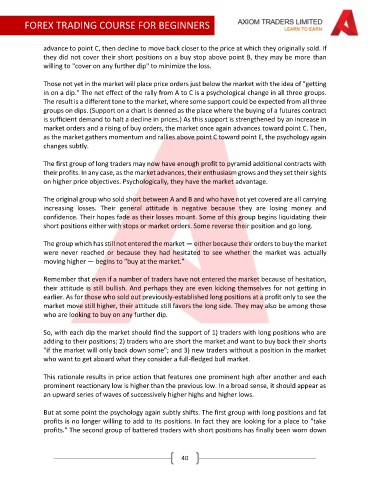Page 40 - NEW FOREX FULL COURSE
P. 40
FOREX TRADING COURSE FOR BEGINNERS
advance to point C, then decline to move back closer to the price at which they originally sold. If
they did not cover their short positions on a buy stop above point B, they may be more than
willing to "cover on any further dip" to minimize the loss.
Those not yet in the market will place price orders just below the market with the idea of "getting
in on a dip." The net effect of the rally from A to C is a psychological change in all three groups.
The result is a different tone to the market, where some support could be expected from all three
groups on dips. (Support on a chart is denned as the place where the buying of a futures contract
is sufficient demand to halt a decline in prices.) As this support is strengthened by an increase in
market orders and a rising of buy orders, the market once again advances toward point C. Then,
as the market gathers momentum and rallies above point C toward point E, the psychology again
changes subtly.
The first group of long traders may now have enough profit to pyramid additional contracts with
their profits. In any case, as the market advances, their enthusiasm grows and they set their sights
on higher price objectives. Psychologically, they have the market advantage.
The original group who sold short between A and B and who have not yet covered are all carrying
increasing losses. Their general attitude is negative because they are losing money and
confidence. Their hopes fade as their losses mount. Some of this group begins liquidating their
short positions either with stops or market orders. Some reverse their position and go long.
The group which has still not entered the market — either because their orders to buy the market
were never reached or because they had hesitated to see whether the market was actually
moving higher — begins to "buy at the market."
Remember that even if a number of traders have not entered the market because of hesitation,
their attitude is still bullish. And perhaps they are even kicking themselves for not getting in
earlier. As for those who sold out previously-established long positions at a profit only to see the
market move still higher, their attitude still favors the long side. They may also be among those
who are looking to buy on any further dip.
So, with each dip the market should find the support of 1) traders with long positions who are
adding to their positions; 2) traders who are short the market and want to buy back their shorts
"if the market will only back down some"; and 3) new traders without a position in the market
who want to get aboard what they consider a full-fledged bull market.
This rationale results in price action that features one prominent high after another and each
prominent reactionary low is higher than the previous low. In a broad sense, it should appear as
an upward series of waves of successively higher highs and higher lows.
But at some point the psychology again subtly shifts. The first group with long positions and fat
profits is no longer willing to add to its positions. In fact they are looking for a place to "take
profits." The second group of battered traders with short positions has finally been worn down
40

